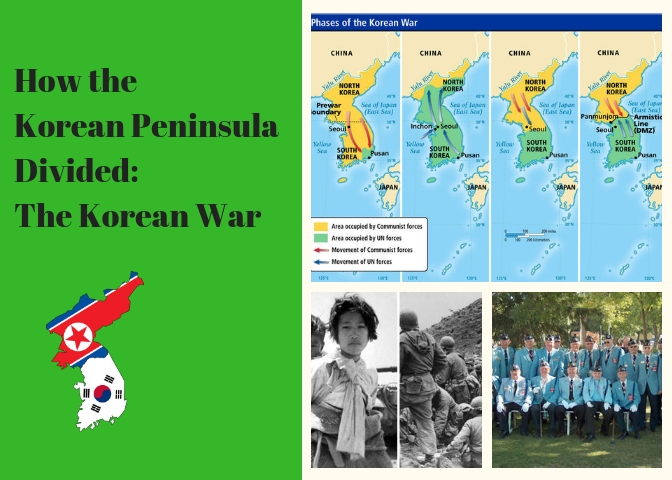How the Korean Peninsula Divided: The Korean War
Earlier this month was Veteran’s Day. We had a Veterans day Assembly too. Veterans of the US army had been through many wars; wars such as World War I, World War II, Civil War, Cold War, Vietnam War…and also this one. The Korean War.
Last time, we had talked about how the Korean Peninsula divided; this time, let’s go a little deeper into the Korean War.
After the conflict with Japan, and to independence, the US and Soviet Union each occupies North Korea and South Korea. Both the North and South claimed that they were the government of the whole Korea, and also didn’t accept the border as permanent. And here’s how the war started for real;
1. North Korea invades South Korea
On June 25, 1950, North Korean forces, aided by the Soviet Union and China, invaded the South. As the North’s forces pushed all the way to the capital, Seoul, governor Sygman Rhee and some of his governors had to evacuate; during the evacuation, they blew up the Hangang Bridge in order to stop the North Korean army. At that time, 4,000 refugees fleeing to the South were crossing the bridge when it was destroyed; many got killed.
The US government sends a request to the UN, to aid the South. So quickly, the UN sends forces to aid the South Korean forces driven back at the edge of the peninsula, a small land known as the Pusan Perimeter.
2. South Korea attempts landing on Inchon
On September 15, 1950, the South Korean and UN forces plans an amphibious landing on Inchon, led by General Douglas MacArthur. Though it took time to get the plan authorized, the attempt succeeds and the South Korean & UN forces recapture Seoul. The US forces start to push on, towards the 38th parallel line; the situation had changed. North Korean forces were pushed back into the north. But China warned that if US crossed the 38th parallel line, China would intervene.
3. China intervenes
The US forces pushed on into crossing the line, anyway. That causes China to intervene; Premier Zhou Enlai informed the UN that Korea is China’s neighbor, so China cannot be but concerned about the solution about the Korean’s problem. The Chinese forces soon joined the North Korean forces, pushing back the US forces behind the 38th parallel line; the two opposing forces began to repeat advancing and retreating for months. The fighting was mostly near the 38th parallel.
4. Armistice
After he argument of agreeing to armistice negotiations continued for two years; it was mostly about returning war prisoners back to the North because the North Korean and Chinese soldiers(war prisoners) refused to be repatriated back to the north. Obviousl,y that was unacceptable for the North Korean government. Eventually, they signed the final armistice agreement on July 27, 1952, under the chairman Indian General K. S. Thimayya. And then the DMZ(demilitarized zone) was created on the 38th parallel line. At las,t the soldiers including the US forces could return back to their homes after such a long, tiring times of war.
Even to these days, the DMZ still exists on the border of North Korea and South Korea. The war was indeed tiring for both sides, and the forces aiding them too. For all soldiers who fought in the Korean War, the end of the almost endless battles indeed would have been a enormous relief.

Yoonjoo is a 7th grade student who loves reading, drawing, and music. She is learning to be more comfortable with computers by working her best as a reporter...





















